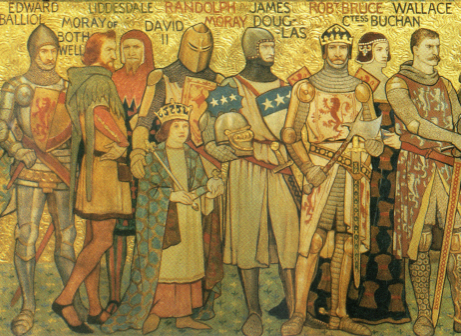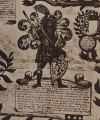|
 Eldest son of
Sir
James of Lothian, Sir William was highly regarded as a military tactician and would became renown as the "Knight of Liddesdale." Through the forfeiture of the Soulises and Lovels, he acquired the Lordship of Dalkeith, the Barony of Aberdour, lands in Tweedsdale, and large holdings in Liddesdale. Eldest son of
Sir
James of Lothian, Sir William was highly regarded as a military tactician and would became renown as the "Knight of Liddesdale." Through the forfeiture of the Soulises and Lovels, he acquired the Lordship of Dalkeith, the Barony of Aberdour, lands in Tweedsdale, and large holdings in Liddesdale.
William Douglas of Liddesdale
visited the King, now 14 years old, at
Chateau Gaillard following his
success in Fife when he captured St Andrews, then held by the English.
He was presumably seeking money. He recruited some crossbowmen and
on his way back to Scotland he hired some French privateers, led by Hugh Hautpool, who helped him blockade the Tay so that the Scots were able to
capture English-held Perth, where William was wounded in the thigh by a
crossbow, and Cupar.
On July 18, 1341 Sir William was granted the Earldom of Atholl in recognition of his valour in resisting Edward Balliol. Preferring to focus his attentions on his lands in the Borders, he resigned the Earldom, on February 16, 1342, In favour of the Lordship of Liddesdale.
On 26th May 1342, Hugh Douglas 'the Dull' resigned a substantial package
of estates, representing the sum total of his landed possessions, to the
crown, in the presence of King David II of Scotland, at an assembly in
Aberdeen. Three days later, at Dundee, King David granted these estates to
Hugh's nephew William, lord of Douglas, and clarified the legal succession
of these lands, entailing them in the male line.
The impressive
collection of lands mentioned in the resignation and subsequent charter
included Douglasdale (vallis de Douglas), Carmichael (Carmichel) and the
burgh of Rutherglen (Rothirglen) in Lanarkshire, Selkirk Forest (foreste de
Selkyrk), Lauderdale (vallis de Lavedre) in Berwickshire, Bedrule (Bethoroule)
and Eskdale (vallis de Esk) in Roxburghshire, Staplegordon (Stabilgortoun)
and Buittle (Botil) in Galloway, and Romanno (Roumanok) in Peebleshire.
Aside from Douglasdale, which the family had controlled since the
twelfth-century, these estates had been granted to Hugh's elder brother 'the
Good' Sir James Douglas by King Robert I of Scotland, as reward for Sir
James's vigorous and ruthlessly effective service in war for the fledgling
Bruce regime. The location of these lands, spread across the south of the
kingdom and with the most significant holdings focused on the Middle March,
illustrate Douglas's status as one of King Robert's most valued war leaders
as well as his crucial role in the defence of the realm.
William Douglas of Liddesdale was granted the Earldom of Atholl in July 1342(1), which had been retained by the crown for some years. He was only to hold the earldom for a matter of months, before being compelled to resign title to King David's uncle, the High Steward of Scotland Robert Stewart (later Robert II of Scotland).
In September of the same year, perhaps in recognition of his loss of the
earldom, King David granted the forfeited lands of Sir James Lovell, in Eskdale
and Ewesdale, to Douglas. Later in 1342, Douglas was again in legal
wrangling with the Steward, being compelled to resign lands he held in wardship
for the young Lord of Douglas, to him. The charter for these lands, in Douglas'
powerbase of Liddesdale was considered defective, because Sir Archibald, the
guardian had granted the lands to himself during King David's minority
 |
| William Douglas, Lord of Liddesdale, as
depicted in an illustrated family tree |
During his lifetime, Sir William was considered the "Flower of Chivalry."
Sir William was murdered in 1353 by his kinsman,
William,
1st Earl of Douglas, in the Ettrick Forest, at a spot later
called William's Cross.
The family possessions passed to the son of his younger brother, Sir John Douglas, who had been assassinated, by order of Sir David Barclay, between 1346 and 1350.
Douglas and Ramsey
Sir Alexander Ramsay of Dalhousie was a great military leader and for his exemplary services was granted by King David of Scotland the post of governor or
Roxburgh Castle and Sheriff of Teviotdale.
Sir William Douglas, Knight of Liddesdale, had distinguished himself for his bravery and military skills during many a siege and engagement with the enemy.
Both men had been brothers in arms in numerous campaigns, and had both shared many victories and accolades.
They were, in fact, outstanding in a brilliant array of valiant knights which thronged the court of King David.
But Douglas was outraged when Ramsay was appointed by the young king, David, as Sheriff of Teviotdale, a post he had held himself and directed his wrath, not on the king who made the appointment, but on Ramsay himself.
Ramsay, in carrying out his official duties, was holding court in the church at Hawick when Douglas burst in. Ramsay rose to greet his old friend and comrade, but he was seized by Douglas's men, who bound him and bore him off to
Hermitage Castle in Liddesdale. There he was hurled into the castle's dungeon and left to starve to death.
This brave knight, it is said, prolonged his life by eating particles of corn which had fallen through the roof from the grain store above.
King David was appalled when he was told of the dreadful crime but his authority was so weak that he was unable to take any action against Douglas.
There is a record that he married Margaret Graham of
Dalkeith, explaining how the lands of Dalkeith came to the Douglases,
however it is recorded elsewhere that his wife was called Elizabeth.
Source: Robert Douglas' Peerage of Scotland
In Chris Brown's excellent book, 'Scottish Battlefields' (2008),
he refers to battles/skirmishes at Blacksollings (circa
1335-1340), Crags o' Craigie (1336 or 1338) and
Crichtondene (1338). All
involved Sir William Douglas of Lothian. This type of
guerrilla warfare and engagements helped the Scots recover after
disastrous reverses at Halidon
Hill and Dupplin
Moor and maintain independence. It is assumed that this
'William of Lothian' is one and the same as the Knight of Liddesdale. You can
view a discussion here>>>
See also:
• Battle of Culblean
• The Douglas Tragedy
Footnote:
• There is some inconsistency here with dates.
Further research is required
• St Andrews Castle was built about 1200 as residence for the
bishop. (In those warlike times the bishop needed a castle to live in).
The English king Edward I captured St Andrews castle (in 1313?). The
Scots recaptured it in 1314. However the English captured the castle
again in 1330. The Scots recaptured St Andrews castle in 1337. This time
they demolished it to prevent it ever falling into English hands again.
However St Andrews Castle was rebuilt in the late 14th century. |
|


